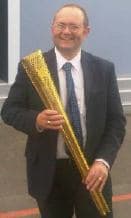
Curated with aloha by
Ted Mooney, P.E. RET

The authoritative public forum
for Metal Finishing 1989-2025

-----
Need Method of Calculating Surface Area of Jet Engine Turbine Airfoils
I need a method of measuring the surface area (in square inches) of the internal and external surfaces of intricate investment castings. These castings are the air-cooled turbine blades and vanes of a jet engine. The geometry of these parts is far to complex to calculate the surface area mathematically.
The measurement method is needed to control the amount of surface preparation that each different type of investment casting receives.
aerospace finisher - Wichita Falls, Texas
Donald,
Personally I haven't a clue about personally solving your problem
... but have you tried the manufacturers of the 'hot' turbine blades?
I was thinking of Specialty Metals (I think that that's their new name) Wiggin Division in Hereford, UK.
Back in the 50's they were producing all the Nimonic series jet engine blades. 'Moulded' NiCr super alloy turbine blades with fir tree roots.
Worth a try if you haven't already done so as at least you'd be able to talk the same language!

Freeman Newton [deceased]
(It is our sad duty to advise that Freeman passed away
April 21, 2012. R.I.P. old friend).
I had a similar problem years ago. We ended up using an electroless plate. The nature of the process insures that uniform thickness will be achieved on all surfaces (in theory). Plate your part and a part with a measureable surface area in the same container. Determine the thickness of the controlled part. Strip both parts very carefully into a measured volume. Once the concentration
(and total plated material) is determined, calculate back using your previous thickness measurement.
Volume of plated material divided by thickness yields total area.
- Utica, New York
Has this been designed on a CAD system?
If so see if you can contact the designer they normally have a button to press on computer to tell you the area of the part.
Even better is the designer who has been trained to put this on the drawing.
We have a few in the UK who write the surface area to be treated on the drawing
eg Chrome plate face Y (Area 1 sq inch)
It is better if you can get the design team to work with you

Martin Trigg-Hogarth
surface treatment shop - Stroud, Glos, England
Just another thought that can some times work on aluminum (I HAVE NOT TRIED THIS MYSELF)
1 Put a plate of the same alloy in an sulfuric anodising bath set it to anodise and once it has formed the first layer the current settles down to a pretty constant value, note this voltage.
2 Put the part in do the same but take it to the voltage noted in step 1.
3 Area can be calculated from the current drawn.
Note This is dependent on several assumptions but should give a reasonable result.

Martin Trigg-Hogarth
surface treatment shop - Stroud, Glos, England
I thank you for your input. The electroless nickel plating is an idea. However, we have many different shapes of turbine vanes and vane rings. This would be very tedious to perform. Also, we do not have the required plating bath. There are no CAD solid models available. All the parts were designed using 2-D CAD.
Donald B. Bellaerospace finisher - Wichita Falls, Texas
Q, A, or Comment on THIS thread -or- Start a NEW Thread